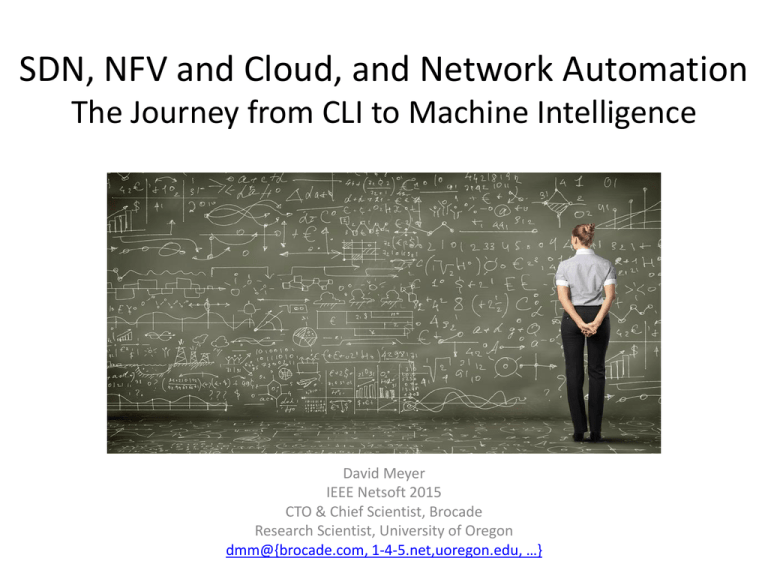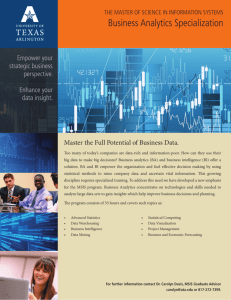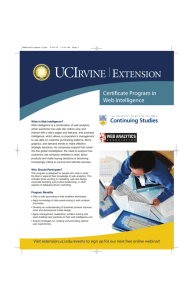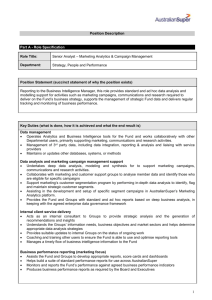SDN, NFV and Cloud, and Network Automation: The Journey from
advertisement

SDN, NFV and Cloud, and Network Automation
The Journey from CLI to Machine Intelligence
David Meyer
IEEE Netsoft 2015
CTO & Chief Scientist, Brocade
Research Scientist, University of Oregon
dmm@{brocade.com, 1-4-5.net,uoregon.edu, …}
Agenda
• Goals for this Talk
• Context and Framing: Automation Continuum
• Software Defined Intelligence
– What kind of architecture do we need for this?
• Briefly: What is Machine Learning?
• Mobile Use Case
• Summary
• Appendix: How can machine learning possibly work?
Goals for this Talks
To give us a basic common
understanding of the analytics and
machine learning landscape
so that we can see the (near) future
and discuss current industry
transitions in the network
automation space.
Agenda
• Goals for this Talk
• Context and Framing: Automation Continuum
• Software Defined Intelligence
– What kind of architecture do we need for this?
• Briefly: What is Machine Learning?
• Mobile Use Case
• Summary
• Appendix: How can machine learning possibly work?
Context and Framing
Lots of excitement around “analytics” and
machine learning
But what are “analytics”, and what use cases are
near term (vs longer term)?
One Way to Segment the Space
• Historical Analytics
– Build data warehouses / run batch queries to predict future events / generate
trend reports
• Near Real-Time Analytics
– Analyze indexed data to provide visibility into current environment / provide
usage reports
• Real-Time Analytics (“streaming”)
– Analyze data as it is created to provide instantaneous, actionable business
intelligence to affect immediate change
– Who’s network gear/software streams data?
• Predictive Analytics
– Build statistical models that can classify/predict the near future
– BTW, how can this work from a technical perspective?
– Maybe more on this later
Another Way To Think About This
The Automation Continuum
Machine Learning
Manual
Automated/Dynamic
CLI
AUTOMATION
INTEGRATION
PROGRAMMABILITY
DEVOPS / NETOPS
ORCHESTRATION
Original slide courtesy Mike Bushong and Joshua Soto
Machine
Intelligence
What Types of Network Centric
Data are Out There?
Profile
User
Analytics
Content
Analytics
Network
Analytics
Slide courtesy Kevin Shatzkamer
Profiling
Identity (Persistent)
Demographics
Explicit profile (interests, etc.)
Device(s) and capabilities
Billing / Subscription plan
Device sensor data
Persistent Location / Presence
Behavioral / Search / Social
Purchasing / Payments
Mobility patterns
Usage data (from device)
Catalog / Title
Topic / Keywords
CA / Rights management
Encryption / DRM
Format(s) / Aspect ratio(s)
Resolution(s) / Frame rate(s)
Consumption data
Content reach
Asset popularity / revenue
Distribution/Retention/Archival
Search / Discover / Recommend
Usage Data (from content source)
Bandwidth and latency
Access types
IP pools
Routes / topology / Path
QoS / Policy Rulesets
Network Service Capabilities
Active subscriber demographics
Crowdsourced data
Geographic segmentation
Network Performance / Quality
Network sensor data (IoT/M2M)
Usage (from DPI)
What Might a (Mobile) Analytics Platform Look Like?
Think “Platform”, not Applications, Algorithm, Visualization
3rd Party Applications
SON
PCRF
SDN
Controller
Service Provider Use-Cases
NFV-O
Index / Schema
(Metadata Mgmt)
Operations
Distributed Data Management
(Pre-filtering, aggregation, normalization (time / location), distribution)
Marketing
Cust. Care
NW Planning
Security
Data Management
(Correlation, trend analysis, pattern recognition)
Data Collection (Push) / Extraction (Pull)
(RAN, IPBH, LTE EPC, Gi LAN, IMS, Network Services, OSS)
Direct API
Tap / SPAN
PCRF
IMS
SDN Svc Chain
eNB
vEPC
CSR
RAN
DPI
NAT
IP Edge
Aggregation
Router
Video Opt.
App Proxy
Gi LAN Services
Slide courtesy Kevin Shatzkamer
Internet
9
Agenda
• Goals for this Talk
• Context and Framing: Automation Continuum
• Software Defined Intelligence
– What kind of architecture do we need for this?
• Briefly: What is Machine Learning?
• Mobile Use Case
• Summary
• Appendix: How can machine learning possibly work?
Where I Want To Go With This
Not This
“Narrow AI”
What Might an Architecture for this Look Like?
Domain
Knowledge
Domain
Knowledge
Domain
DomainKnowledge
Knowledge
Software Defined Intelligence
Architecture Strawman
3rd party Applications
Analytics Platform
Presentation Layer
Data
Collection
Packet brokers, flow data, …
Preprocessing
Big Data, Hadoop, Data
Science, …
Intelligence
Learning
Model Generation
Oracle
Machine Learning
Model(s)
Remediation/Optimization/…
Oracle
Logic
Topology, Anomaly Detection,
Root Cause Analysis,
Predictive Insight, ….
Aside: NVIDA
Agenda
• Goals for this Talk
• Context and Framing: Automation Continuum
• Software Defined Intelligence
– What kind of architecture do we need for this?
• Briefly: What is Machine Learning?
• Mobile Use Case
• Summary
• Appendix: How can machine learning possibly work?
Goals for this Section
To cut through some of the Machine
Learning (ML) hype and give us a
basic common understanding of ML
so that we can discuss its application
to our use cases of interest.
So, remembering our strawman architecture…
Strawman Architecture
Domain
Knowledge
Domain
Knowledge
Domain
DomainKnowledge
Knowledge
Presentation Layer
Data
Collection
Packet brokers, flow data, …
Preprocessing
Big Data, Hadoop, Data
Science, …
3rd party Applications
Focus Here
Model Generation
Oracle
Machine Learning
Model(s)
Remediation/Optimization/…
Oracle
Logic
Before We Start
What is the SOTA in Machine Learning?
• “Building High-level Features Using Large Scale Unsupervised Learning”,
Andrew Ng, et. al, 2012
– http://arxiv.org/pdf/1112.6209.pdf
– Training a deep neural network
– Showed that it is possible to train neurons to be selective for high-level concepts using
entirely unlabeled data
– In particular, they trained a deep neural network that functions as detectors for faces,
human bodies, and cat faces by training on random frames of YouTube videos
(ImageNet1). These neurons naturally capture complex invariances such as out-of-plane
rotation, scale invariance, …
• Details of the Model
– Sparse deep auto-encoder (catch me later if you are interested what this is/how it
works)
– O(109) connections
– O(107) 200x200 pixel images, 103 machines, 16K cores
• Input data in R40000
• Three days to train
– 15.8% accuracy categorizing 22K object classes
• 70% improvement over current results
• Random guess achieves less than 0.005% accuracy for this dataset
1 http://www.image-net.org/
What is Machine Learning?
The complexity in traditional computer programming is
in the code (programs that people write). In machine
learning, algorithms (programs) are in principle simple
and the complexity (structure) is in the data. Is there a
way that we can automatically learn that structure? That
is what is at the heart of machine learning.
-- Andrew Ng
That is, machine learning is the about the construction and study
of systems that can learn from data. This is very different than
traditional computer programming.
The Same Thing Said in Cartoon Form
Traditional Programming
Data
Program
Computer
Output
Computer
Program
Machine Learning
Data
Output
When Would We Use Machine Learning?
•
When patterns exists in our data
–
Even if we don’t know what they are
•
•
We can not pin down the functional relationships mathematically
–
•
Else we would just code up the algorithm
When we have lots of (unlabeled) data
–
–
Labeled training sets harder to come by
Data is of high-dimension
•
•
–
High dimension “features”
For example, network telemetry and/or sensor data
Want to “discover” lower-dimension representations
•
•
Or perhaps especially when we don’t know what they are
Dimension reduction
Aside: Machine Learning is heavily focused on implementability
–
–
Frequently using well know numerical optimization techniques
Lots of open source code available
•
•
•
•
See e.g., libsvm (Support Vector Machines): http://www.csie.ntu.edu.tw/~cjlin/libsvm/
Most of my code in python: http://scikit-learn.org/stable/ (many others)
Languages (e.g., octave: https://www.gnu.org/software/octave/)
Newer: Torch: http://torch.ch/ (lua)
Why Machine Learning is Hard?
You See
Your ML Algorithm Sees
A Bunch of Bits
Why Machine Learning Is Hard, Redux
What is a “2”?
Examples of Machine Learning Problems
• Pattern Recognition
–
–
–
–
Facial identities or facial expressions
Handwritten or spoken words (e.g., Siri)
Medical images
Sensor Data/IoT
• Optimization
– Many parameters have “hidden” relationships that can be the basis of optimization
• Pattern Generation
– Generating images or motion sequences
• Anomaly Detection
–
–
–
Unusual patterns in the telemetry from physical and/or virtual plants (e.g., data centers)
Unusual sequences of credit card transactions
Unusual patterns of sensor data from a nuclear power plant
•
or unusual sound in your car engine or …
• Prediction
– Future stock prices or currency exchange rates
– Network events/hardware failures, …
– …
Ok, But What Exactly Is Machine Learning?
•
Machine Learning is a procedure that consists of estimating the model parameters so that
the learned model (algorithm) can perform a specific task
– Typically try estimate model parameters such that prediction error is minimized
•
2 types of learning considered here
–
–
–
–
•
Supervised
Unsupervised
Semi-supervised learning
Reinforcement learning
Supervised learning
– Present the algorithm with a set of inputs and their corresponding outputs
– Essentially have a “teacher” that tells you what each training example is
– See how closely the actual outputs match the desired ones
•
Note generalization error (bias, variance)
– Iteratively modify the parameters to better approximate the desired outputs (gradient descent)
•
Unsupervised
– Algorithm learns internal representations and important features
•
So let’s take a closer look at these learning types
Supervised learning
• You are given training data and “what each item is”
– e.g., a set of images and corresponding descriptions (labels)
• “this is a cat” or “this is a chair” (cat or chair is a label)
– Training set consists of (x(i),y(i)) pairs, x(i) is the input example, y(i) is the label
– You want to find f(x(i)) = y(i), but you don’t know f
• Another way to look at the training set: (x(i),y(i)) = (x(i), f(x(i)))
• Goal: accurately {predict,classify,compute} the label for previous unseen x
– Learning comes down to finding a parameter set for your model that
minimizes prediction error learning is an optimization problem
• There are many 10s (if not 10^2s or 10^3s) of supervised
learning algorithms
– These include: Artificial Neural Networks, Decision Trees, Ensembles
(Bagging, Boosting, Random Forests, …), k-NN, Linear Regression, Naive
Bayes, Logistic Regression (and other CRFs), Support Vector Machines (and
other Large Margin Classifiers), …
Unsupervised learning
• Basic idea: Discover unknown compositional structure in input data
• Data clustering and dimension reduction
– More generally: find the relationships/structure in the data set
• No need for labeled data
– The network itself finds the correlations in the data
• Learning algorithms include (again, many algorithms)
– K-Means Clustering
– Auto-encoders/deep neural networks
– Restricted Boltzmann Machines
• Hopfield Networks
– Sparse Encoders
– …
Taxonomy of Learning Techniques
Where the
excitement
is happening
Slide courtesy Yoshua Bengio
Artificial Neural Networks
• A Bit of History
• Biological Inspiration
• Artificial Neurons (AN)
• Artificial Neural Networks (ANN)
• Computational Power of Single AN
• Computational Power of an ANN
• Training an ANN -- Learning
Brief History of Neural Networks
• 1943: McCulloch & Pitts show that neurons can be
combined to construct a Turing machine (using ANDs, ORs,
& NOTs)
• 1958: Rosenblatt shows that perceptrons will converge if
what they are trying to learn can be represented
• 1969: Minsky & Papert showed the limitations of
perceptrons, killing research for a decade
• 1985: The backpropagation algorithm revitalizes the field
– Geoff Hinton et al
• 2006: The Hinton lab solves the training problem for DNNs
Biological Inspiration: Neurons
(but be careful…)
• A neuron has
– Branching input (dendrites)
– Branching output (the axon)
• Information moves from the dendrites to the axon via the cell body
• Axon connects to dendrites via synapses
– Synapses vary in strength
– Synapses may be excitatory or inhibitory
What is an Artificial Neuron?
(easy math )
• An Artificial Neuron (AN) is a non-linear
parameterized function with restricted output
range
bias term
y
b
w1
x1
w2
x2
w3
x3
æ n-1
ö
y = f ç b + å wi xi ÷
è
ø
i=1
tiny non-linearity
(activation function)
linear combination
Mapping to Biological Neurons
Dendrite Cell Body Axon
Ok, Then What is an
Artificial Neural Network (ANN)?
•
An ANN is mathematical model designed to solve
engineering problems
–
•
Group of highly connected artificial neurons to realize compositions
of non-linear functions (usually one of the ones we just looked at)
Tasks
–
–
–
•
Classification
Discrimination
Estimation
2 main types of networks
–
–
Feed forward Neural Networks
Recurrent Neural Networks
Feed Forward Neural Networks
•
The information is propagated from
the inputs to the outputs
– Directed Acyclic Graph (DAG)
Output layer
•
2nd hidden
layer
Computes one or more non-linear
functions
– Computation is carried out by
composition of some number of
algebraic functions implemented by
the connections, weights and biases
of the hidden and output layers
1st hidden
layer
•
Hidden layers compute
intermediate representations
– Dimension reduction
•
x1
x2
…..
Time has no role -- no cycles
between outputs and inputs
xn
We say that the input data, or features, are n dimensional
– However, in some models each
hidden layer models one time step
Deep Feed Forward Neural Nets
(all the math I’m going to give you is on this slide )
(x(i),y(i))
hθ(x(i))
Hypothesis
f(x(i))
Forward Propagation
So what then is learning?
Learning is the adjusting of the weights wi,j such that
the cost function J(θ) is minimized
Simple learning procedure: Back Propagation (of the error signal)
Forward Propagation Cartoon
Back propagation Cartoon
Agenda
• Goals for this Talk
• Context and Framing: Automation Continuum
• Software Defined Intelligence
– What kind of architecture do we need for this?
• Briefly: What is Machine Learning?
• Mobile Use Case
• Summary
• Appendix: How can machine learning possibly work?
Now, How About Mobile Use Cases?
• Mobile ideally suited to SDN, NFV and Machine Learning
– More generally, {SDN,NFV,Cloud} ideally suited to ML
• Can we infer properties of paths/equipment/users we can’t directly see?
– Likely living in high-dimensional space(es)
– i.e., those in other domains
• Other inference tasks?
–
–
–
–
–
Aggregate bandwidth consumption
Most loaded links/congestion
Cumulative cost of path set
Uncover unseen correlations that allow for new optimizations
And of course, anomaly detection (applies to almost every use case)
• How to get there from here
– Applying Machine Learning to the Mobile space requires understanding the
problem you want to solve and what data sets you have
(Near) Future Mobile Architecture
NFV-O
MME
SGW-C PGW-C
HSS
OFCS
OCS
PCRF
DPI
NAT
SON
Video
Opt.
3rd
Party
Analytics
IMS
Subscriber Information Base (Shared Session State Database)
SDN Controller
eNB
S1-MME
SGi
IPv6
RAN
•
•
•
•
•
•
•
CSR
S1-U
SGi
Internet
Control Functions Integrated into NFV, Bearer Functions Integrated into SDN
Enhanced NB and SB APIs in SDN Controller
SGW-C and PGW-C maintain 3GPP-compliant external interfaces (S1-U, S5, S11, SGi, S7/Gx, Gy, Gz)
Integrated Security (Firewall, NAT), removal of physical boundary constraints
Session State Convergence: Subscriber Management delivered via shared columnar/hybrid database
Integrated SON + SDN + NFV-O for Radio + Network + Datacenter policy convergence
Open APIs (Database, Controller, Orchestrator) for 3rd Party Applications
Slide courtesy Kevin Shatzkamer
A Few Data Principles for Future
Mobile Architectures
•
Elastic (for the variance)
•
Access:
Baseband Processing (Cloud RAN), RAN Controllers (Cloud Controllers)
Core:
Evolved Packet Core, Video Optimization, Deep Packet Inspection, NAT, Firewall, VPN
Services:
VoLTE/IMS, Video, CDN, Policy, Identity
SDP:
APIs, M2M
Hardware-independence + Virtualization + VM Mobility
•
Scalable (for the aggregate)
•
Highly distributed bearer plane
Independent control plane (inline or centralized)
Policy + Orchestration = Subscriber + Resource Optimization
•
Dynamic (Evolving to Self-Organizing)
•
Use analytics models unpredictability in Aggregates and Variances
Dynamic decisions (manual or automatic intervention) based on analytics
Adaptable routing/forwarding decisions that follow mobility events (subscribers, content, identity, services,
applications, virtual machines)
•
Cost-Effective (OPEX and CAPEX)
© 2014 BROCADE COMMUNICATIONS SYSTEMS, INC. CONFIDENTIAL—FOR INTERNAL USE ONLY
42
What would a Mobile Data Set
for Machine Learning look like?
•
Assume we have labeled data set
– {(X(1),Y(1)),…,(X(n),Y(n))}
• Where X(i) is an m-dimensional vector, and
• Y(i) is usually a k dimensional vector, k < m
•
Strawman X (the network has this information, and much much more)
•
X(i) = (Path end points,
Desired path constraints,
Signal impairment,
Computed path,
Aggregate path constraints (e.g. path cost),
Minimum cost path,
Minimum load path,
Maximum residual bandwidth path,
Aggregate bandwidth consumption,
Load of the most loaded link,
Cumulative cost of a set of paths,
(some measure of buffer occupancy),
…,
Other (possibly exogenous) data)
•
If we have Y(i)’s are a set of classes we want to predict, e.g., congestion, latency, …
What Might the Labels Look Like?
(sparseness)
(instance)
Issues/Challenges
• Is there a unique model that we can learn?
– Concept Drift
– averaging models over training sets and over time
• Unlabeled vs. Labeled Data
– Most commercial successes in ML have come with deep supervised learning
– We don’t have ready access to large labeled data sets (always a problem)
• Training vs. {prediction,classification} Complexity
– Stochastic (online) vs. Batch vs. Mini-batch
– Where are the computational bottlenecks, and how do those
interact with (quasi) real time requirements?
• Technical Skills
– ML today is a technical (mathematical) discipline
Finally, in the event that you think
Machine Learning is Science Fiction…
Agenda
• Goals for this Talk
• Context and Framing: Automation Continuum
• Software Defined Intelligence
– What kind of architecture do we need for this?
• Briefly: What is Machine Learning?
• Mobile Use Case
• Summary
• Appendix: How can machine learning possibly work?
Summary
• ML is real now, chiefly because of
– the availability of large data sets
– increased compute/storage capability
– theoretical breakthroughs in deep learning
• Networking is an ideal ML use case
– Large and diverse data sets, deep structure
• We will see dramatic changes in the way networks are built and operated
starting this year as a direct consequence of the incorporation of Machine
Learning technologies into network design, engineering and operation
tasks
• As networking professionals, we need to prepare
– {SDN,NFV,Cloud} is a sea-change in how we think about infrastructure
• Disaggregation
– ML is a sea-change in the way we think think about design, control, operation, and
management of that infrastructure
• Remember the optimization/remediation/ loop in our architecture
Q&A
Thanks!
How Can Machine Learning Possibly Work?
•
We want to build statistical models that generalize to unseen cases
•
What assumptions do we need to do this (essentially predict the future)?
•
4 main “prior” assumptions are (at least) required
–
Smoothness
–
Manifold Hypothesis
–
Distributed Representation/Compositionality
•
•
•
Compositionality is useful to describe the world around us efficiently distributed representations (features)
are meaningful by themselves.
Non-distributed # of distinguishable regions linear in # of parameters
Distributed
# of distinguishable regions grows almost exponentially in # of parameters
–
•
–
Want to generalize non-locally to never-seen regions essentially exponential gain
Shared Underlying Explanatory Factors
•
•
Each parameter influences many regions, not just local neighbors
The assumption here is that there are shared underlying explanatory factors, in particular between p(x) (prior
distribution) and p(Y|x) (posterior distribution). Disentangling these factors is in part what machine learning is
about.
Before this, however: What is the problem in the first place?
Why ML Is Hard
The Curse Of Dimensionality
• To generalize locally, you
need representative
examples from all
relevant variations (and
there are an exponential
number of them)!
• Classical Solution: Hope
for a smooth enough
target function, or make it
smooth by handcrafting
good features or kernels
• Smooth?
(i). Space grows exponentially
(ii). Space is stretched, points
become equidistant
So What Is Smoothness?
Smoothness If x is geometrically close to x’ then f(x) ≈ f(x’)
Smoothness, basically…
Probability mass P(Y=c|X;θ)
This is where the Manifold Hypothesis comes in…
Manifold Hypothesis
The Manifold Hypothesis states that natural data forms lower dimensional manifolds
in its embedding space. Why should this be? Well, it seems that there are both
theoretical and experimental reasons to suspect that the Manifold Hypothesis is true.
So if you believe that the MH is true, then the task of a machine learning classification
algorithm is fundamentally to separate a bunch of tangled up manifolds.
Another View: Manifolds and Classes







